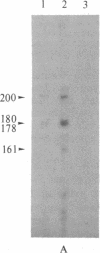Abstract
The synthesis and degradation of fructose 2,6-bisphosphate, a ubiquitous stimulator of glycolysis, are catalyzed by 6-phosphofructo-2-kinase (EC 2.7.1.105) and fructose-2,6-bisphosphatase (EC 3.1.3.46), respectively. In liver, these two activities belong to separate domains of the same 470-residue polypeptide. Various mRNAs have been described for this bifunctional enzyme, which is controlled by hormonal and metabolic signals. To understand the origin and regulation of these mRNAs, we have characterized rat genomic clones encoding the liver isozyme, which is regulated by cAMP-dependent protein kinase, and the muscle isozyme, which is not. We describe here a 55-kilobase gene that encodes these isozymes by alternative splicing from two promoters. Each of the putative promoters was sequenced over about 3 kilobases and found to include nucleotide motifs for binding regulatory factors. The two isozymes share the same 13 exons and differ only by the first exon that, in the liver but not in the muscle isozyme, contains the serine phosphorylated by cAMP-dependent protein kinase. The gene was assigned to the X chromosome. An analysis of the exon limits of 6-phosphofructo-2-kinase/fructose-2,6-bisphosphatase in relation to its functional domains and to its similarity with other proteins plus its G + C content at the third codon position suggests that this gene originates from several fusion events.
Full text
PDF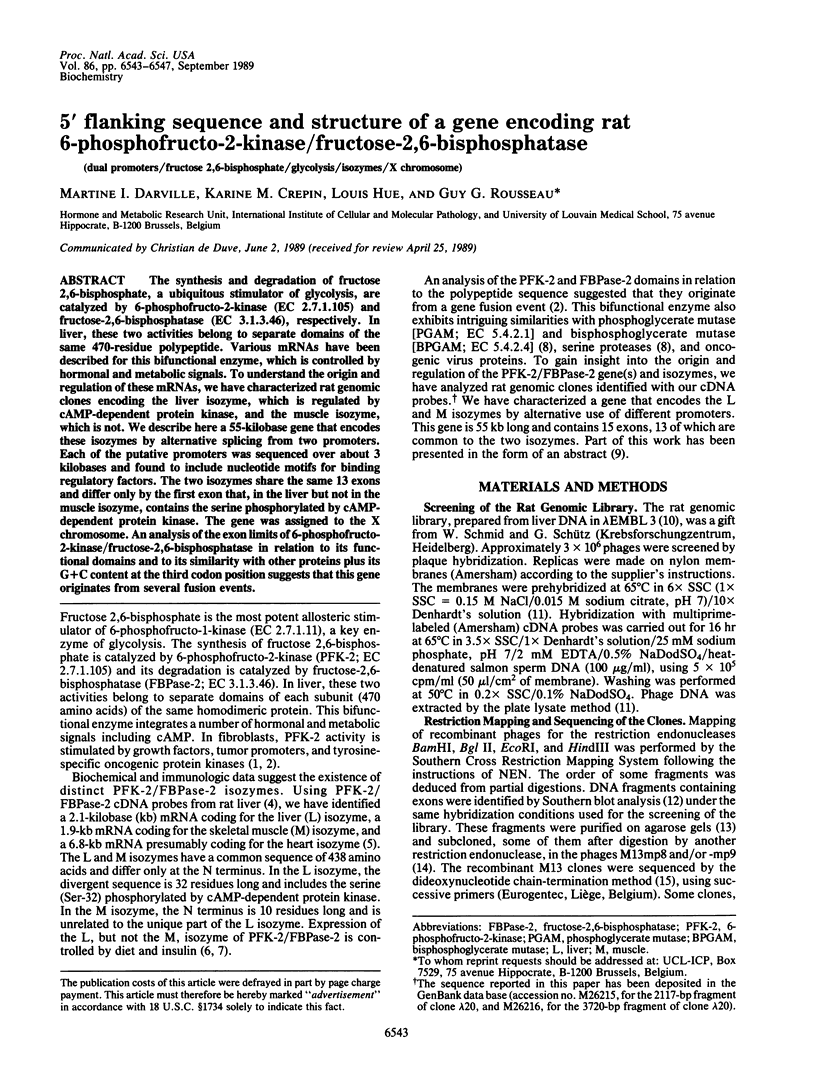
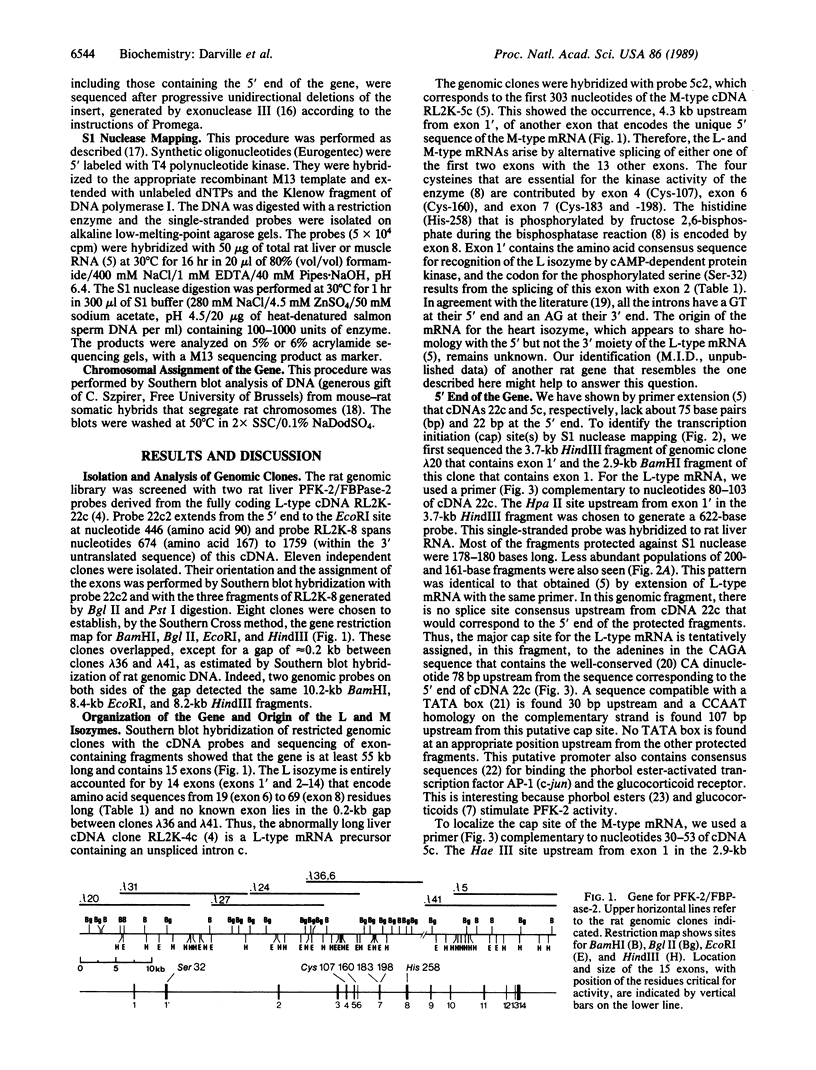
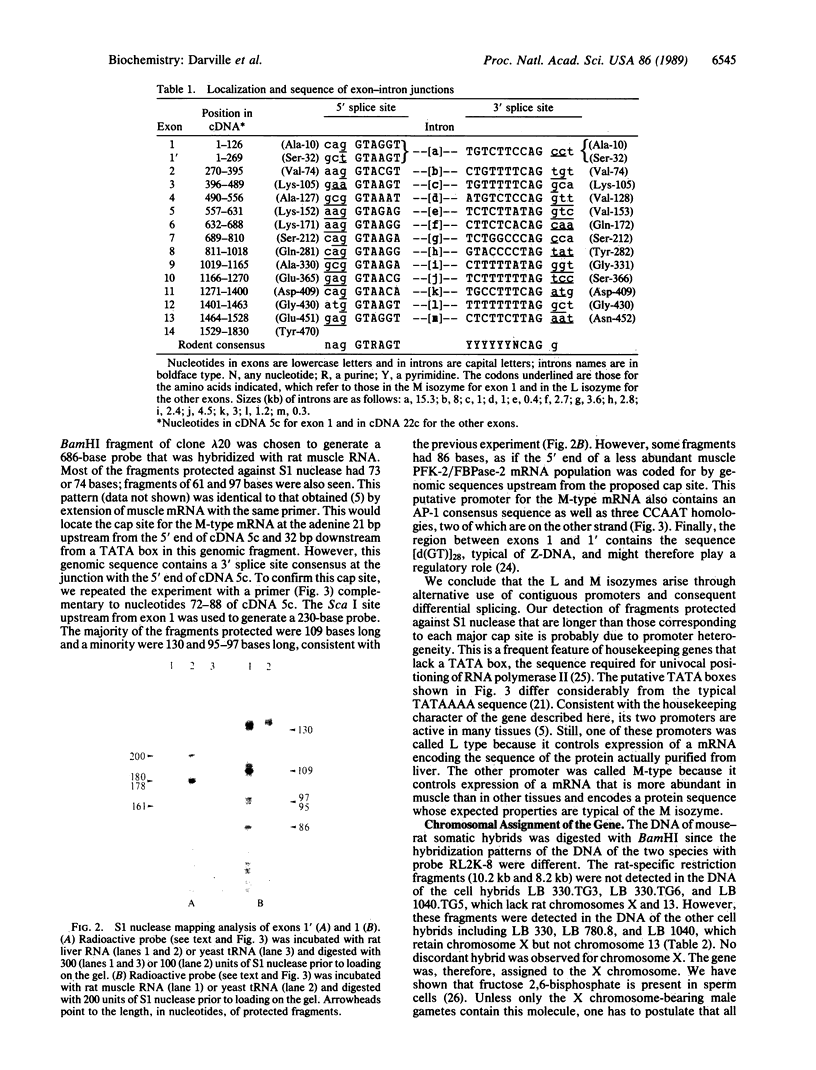
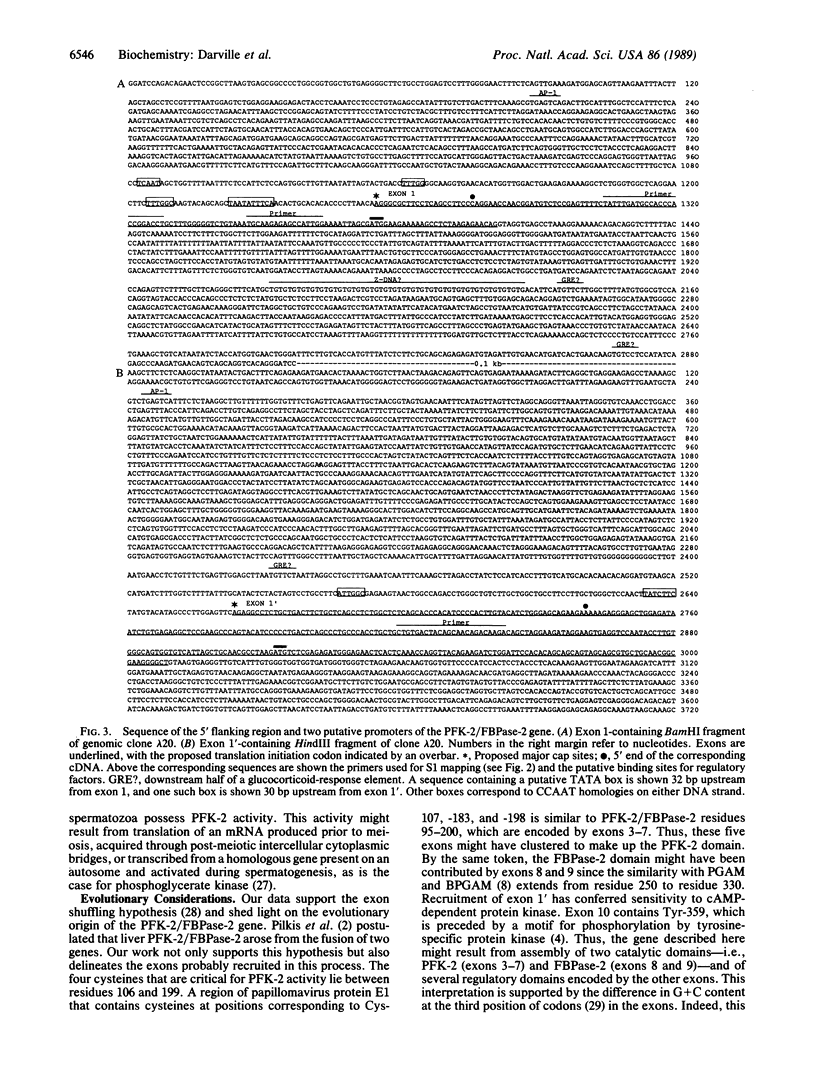
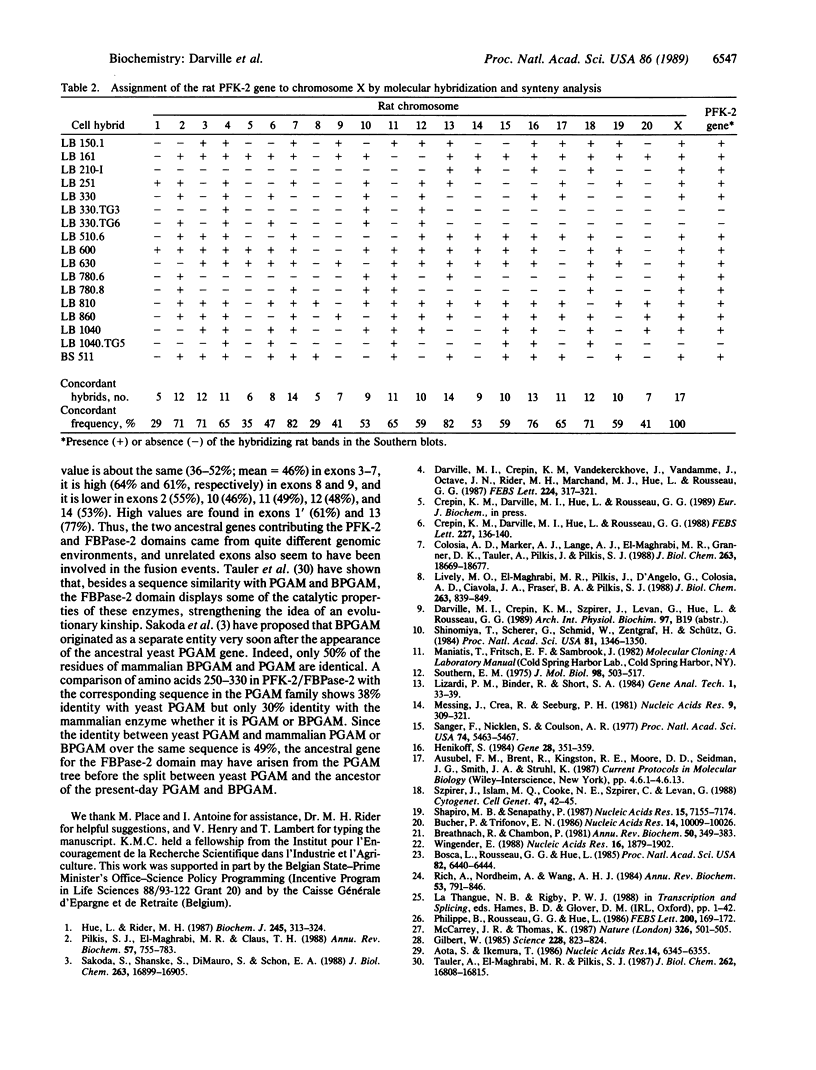
Images in this article
Selected References
These references are in PubMed. This may not be the complete list of references from this article.
- Aota S., Ikemura T. Diversity in G + C content at the third position of codons in vertebrate genes and its cause. Nucleic Acids Res. 1986 Aug 26;14(16):6345–6355. doi: 10.1093/nar/14.16.6345. [DOI] [PMC free article] [PubMed] [Google Scholar]
- Bosca L., Rousseau G. G., Hue L. Phorbol 12-myristate 13-acetate and insulin increase the concentration of fructose 2,6-bisphosphate and stimulate glycolysis in chicken embryo fibroblasts. Proc Natl Acad Sci U S A. 1985 Oct;82(19):6440–6444. doi: 10.1073/pnas.82.19.6440. [DOI] [PMC free article] [PubMed] [Google Scholar]
- Breathnach R., Chambon P. Organization and expression of eucaryotic split genes coding for proteins. Annu Rev Biochem. 1981;50:349–383. doi: 10.1146/annurev.bi.50.070181.002025. [DOI] [PubMed] [Google Scholar]
- Bucher P., Trifonov E. N. Compilation and analysis of eukaryotic POL II promoter sequences. Nucleic Acids Res. 1986 Dec 22;14(24):10009–10026. doi: 10.1093/nar/14.24.10009. [DOI] [PMC free article] [PubMed] [Google Scholar]
- Colosia A. D., Marker A. J., Lange A. J., el-Maghrabi M. R., Granner D. K., Tauler A., Pilkis J., Pilkis S. J. Induction of rat liver 6-phosphofructo-2-kinase/fructose-2,6-bisphosphatase mRNA by refeeding and insulin. J Biol Chem. 1988 Dec 15;263(35):18669–18677. [PubMed] [Google Scholar]
- Crepin K. M., Darville M. I., Hue L., Rousseau G. G. Starvation or diabetes decreases the content but not the mRNA of 6-phosphofructo-2-kinase in rat liver. FEBS Lett. 1988 Jan 25;227(2):136–140. doi: 10.1016/0014-5793(88)80884-6. [DOI] [PubMed] [Google Scholar]
- Darville M. I., Crepin K. M., Vandekerckhove J., Van Damme J., Octave J. N., Rider M. H., Marchand M. J., Hue L., Rousseau G. G. Complete nucleotide sequence coding for rat liver 6-phosphofructo-2-kinase/fructose-2,6-bisphosphatase derived from a cDNA clone. FEBS Lett. 1987 Nov 30;224(2):317–321. doi: 10.1016/0014-5793(87)80476-3. [DOI] [PubMed] [Google Scholar]
- Gilbert W. Genes-in-pieces revisited. Science. 1985 May 17;228(4701):823–824. doi: 10.1126/science.4001923. [DOI] [PubMed] [Google Scholar]
- Henikoff S. Unidirectional digestion with exonuclease III creates targeted breakpoints for DNA sequencing. Gene. 1984 Jun;28(3):351–359. doi: 10.1016/0378-1119(84)90153-7. [DOI] [PubMed] [Google Scholar]
- Hue L., Rider M. H. Role of fructose 2,6-bisphosphate in the control of glycolysis in mammalian tissues. Biochem J. 1987 Jul 15;245(2):313–324. doi: 10.1042/bj2450313. [DOI] [PMC free article] [PubMed] [Google Scholar]
- Lively M. O., el-Maghrabi M. R., Pilkis J., D'Angelo G., Colosia A. D., Ciavola J. A., Fraser B. A., Pilkis S. J. Complete amino acid sequence of rat liver 6-phosphofructo-2-kinase/fructose-2,6-bisphosphatase. J Biol Chem. 1988 Jan 15;263(2):839–849. [PubMed] [Google Scholar]
- McCarrey J. R., Thomas K. Human testis-specific PGK gene lacks introns and possesses characteristics of a processed gene. Nature. 1987 Apr 2;326(6112):501–505. doi: 10.1038/326501a0. [DOI] [PubMed] [Google Scholar]
- Messing J., Crea R., Seeburg P. H. A system for shotgun DNA sequencing. Nucleic Acids Res. 1981 Jan 24;9(2):309–321. doi: 10.1093/nar/9.2.309. [DOI] [PMC free article] [PubMed] [Google Scholar]
- Philippe B., Rousseau G. G., Hue L. Fructose 2,6-bisphosphate and the control of glycolysis in bovine spermatozoa. FEBS Lett. 1986 May 5;200(1):169–172. doi: 10.1016/0014-5793(86)80532-4. [DOI] [PubMed] [Google Scholar]
- Pilkis S. J., el-Maghrabi M. R., Claus T. H. Hormonal regulation of hepatic gluconeogenesis and glycolysis. Annu Rev Biochem. 1988;57:755–783. doi: 10.1146/annurev.bi.57.070188.003543. [DOI] [PubMed] [Google Scholar]
- Rich A., Nordheim A., Wang A. H. The chemistry and biology of left-handed Z-DNA. Annu Rev Biochem. 1984;53:791–846. doi: 10.1146/annurev.bi.53.070184.004043. [DOI] [PubMed] [Google Scholar]
- Sakoda S., Shanske S., DiMauro S., Schon E. A. Isolation of a cDNA encoding the B isozyme of human phosphoglycerate mutase (PGAM) and characterization of the PGAM gene family. J Biol Chem. 1988 Nov 15;263(32):16899–16905. [PubMed] [Google Scholar]
- Sanger F., Nicklen S., Coulson A. R. DNA sequencing with chain-terminating inhibitors. Proc Natl Acad Sci U S A. 1977 Dec;74(12):5463–5467. doi: 10.1073/pnas.74.12.5463. [DOI] [PMC free article] [PubMed] [Google Scholar]
- Shapiro M. B., Senapathy P. RNA splice junctions of different classes of eukaryotes: sequence statistics and functional implications in gene expression. Nucleic Acids Res. 1987 Sep 11;15(17):7155–7174. doi: 10.1093/nar/15.17.7155. [DOI] [PMC free article] [PubMed] [Google Scholar]
- Shinomiya T., Scherer G., Schmid W., Zentgraf H., Schütz G. Isolation and characterization of the rat tyrosine aminotransferase gene. Proc Natl Acad Sci U S A. 1984 Mar;81(5):1346–1350. doi: 10.1073/pnas.81.5.1346. [DOI] [PMC free article] [PubMed] [Google Scholar]
- Southern E. M. Detection of specific sequences among DNA fragments separated by gel electrophoresis. J Mol Biol. 1975 Nov 5;98(3):503–517. doi: 10.1016/s0022-2836(75)80083-0. [DOI] [PubMed] [Google Scholar]
- Szpirer J., Islam M. Q., Cooke N. E., Szpirer C., Levan G. Assignment of three rat genes coding for plasma proteins, transferrin, third component of complement, and beta-fibrinogen to rat chromosomes 8, 9, and 2. Cytogenet Cell Genet. 1988;47(1-2):42–45. doi: 10.1159/000132502. [DOI] [PubMed] [Google Scholar]
- Tauler A., el-Maghrabi M. R., Pilkis S. J. Functional homology of 6-phosphofructo-2-kinase/fructose-2,6-bisphosphatase, phosphoglycerate mutase, and 2,3-bisphosphoglycerate mutase. J Biol Chem. 1987 Dec 15;262(35):16808–16815. [PubMed] [Google Scholar]
- Wingender E. Compilation of transcription regulating proteins. Nucleic Acids Res. 1988 Mar 25;16(5):1879–1902. doi: 10.1093/nar/16.5.1879. [DOI] [PMC free article] [PubMed] [Google Scholar]



